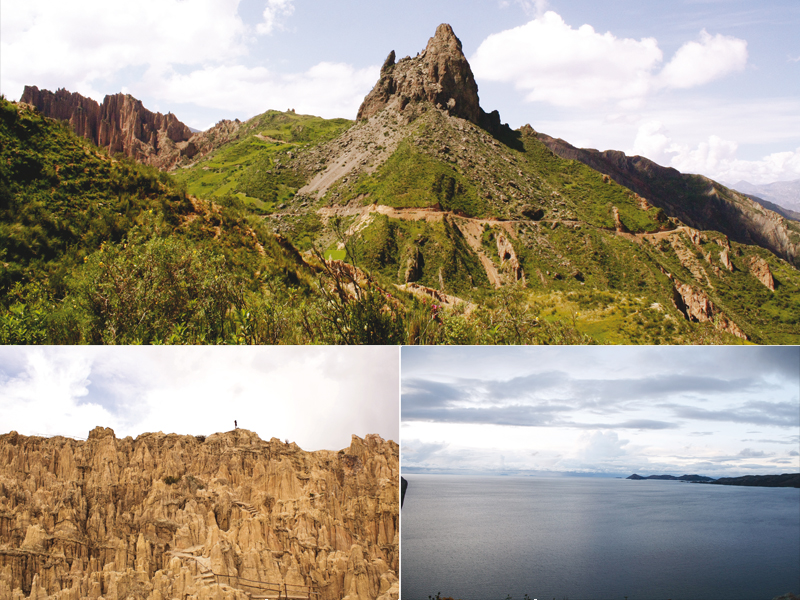
Our Bolivian journey begins in La Paz after landing in El Alto (part of greater La Paz) at the El Alto International Airport. If you’re brave enough to arrive in the dead of night, you can avoid the morbid-looking scarecrows hung on lampposts — a sign to ward off thieves and not crows. In earlier times, the scarecrows were apparently bodies of thieves who had been executed if caught and hung high to instil fear in criminals.

El Alto gives street justice a new definition altogether but that is not the only defining point of the city. La Paz is a culturally rich, sprawling and chaotic city with just around three million inhabitants. It represents modern Bolivia with its restaurants, bars, universities and museums and the hard-to-miss Witches’ Market which, quite like the name suggests, offers an interesting selection of good luck charms and voodoo-like items. Dead baby llama foetuses are also sold here and according to a myth, if you bury one under a building before construction, the fetus will act as its protector.
Although grateful for the revenue that tourism brings in, the inhabitants don’t seem too pleased by the horde of backpackers who flock to La Paz each year. The heavy tourist influx is not just limited to La Paz but can be seen all across Bolivia.

From La Paz, one of the easiest trips to make is to Copacabana, a small town beside the infamous Lake Titicaca, believed to be the birthplace of the Incas, one of the oldest knows civilisations in the Americas. Its intense azul sky and reflections during sunset almost make you believe the same. The remainder of the town is graced with only about six short streets, lined with bars, shops and restaurants. There isn’t much to do here other than wander around.
With a quick look at South America’s largest lake and also one the world’s highest large lakes, you can now head to the town of Corioco. Its tropical climate and thriving jungle will allow you to put your adventure gear to good use. Here you can go hiking through the tropical mountains, bathe under the waterfalls or go river rafting. And if you desire a more upscale experience, you can lounge around your hotel pool all day. A mere three hours away from La Paz, Corioco is the ideal getaway.

Cochabamba on the other hand is a vibrant and thriving Bolivian city. It hosted the world’s largest statue of Jesus Christ until 2010, when a larger one was completed in Poland. As another one of Bolivia’s larger cities, Cochabamba is quite different from La Paz — and actually quite like Karachi and Lahore.
The city holds a wealth of archaeological treasures. Rising above the surrounding tile roofs is the dome of the convent of Santa Teresa, perhaps one of the world’s most underrated wonders. Designed and constructed by architect Pedro Nogales and engineer Martinez Caceres in 1760, the convent exudes a sense of peace that touches those who walk down its hallway. And as the guidebook rightly states: “It looks like you have walked into a Gabriel Garcia Marquez novel.” The convent houses a small number of nuns who have devoted themselves to the place and are not allowed to speak or interact with anyone from the outside world. Until 2005, they resided in the convent’s original structure, in dire conditions.
From sacred to simply serene, Bolivia is dotted with abundant tourist destinations. Only a few Bolivianos can take you a very long way, also making it an extremely budget-friendly holiday. For instance, for around 90 Bolivianos (Rs1,400) you can travel for 16 hours in a bus, in a comfortable cama seat that can fold down quite literally into a bed.
Unfortunately for those who suffer from vertigo, it is one of the most economical ways to get to Salar de Uyuni, the world’s largest salt flat. It offers a truly magnificent sight, especially if you can manage to get there well before 100 other jeeps make it their parking lot. With a little bit of rain, the dried, crusty salt plains form the world’s largest natural mirror and it is almost sinful to not try and capture this beauty on camera.
South-West Bolivia has a lot more to offer other than the savage beauty of the salt flat. If you have a booked a tour, you will embark on a spectacular three-to-seven day journey that will take you through its arid deserts, hot springs, the red lake that is home to flamingos, the green lake with enough arsenic to kill anyone who attempts to take a swim in it and stunning mountains and rock formations along the way.
Mountains are plentiful in this country, especially in its silver mining city of Potosi. It used to be the largest city in the world at one point in time — larger than London and Brussels. This was due to the silver-rich mountains that provided thousands of miners with jobs. But after the price of silver dramatically fell in the international market, times in Potosi got tough.
The first thing that strikes you about this city is the grit — in the streets, in the cafés and in the city’s architecture. As an additional source of revenue, miners now offer mine tours. This comprises a four-hour crawl through jagged tunnels illuminated by torches, with a tour guide repeatedly shouting, “don’t look up, sulphuric acid is dripping from the ceiling.” Later you are required to climb down to an unused tunnel to light up a few sticks of dynamite, right after wishing for good luck before the statue of El Tio (The Uncle), Lord of the Underworld who is believed to be the protector of the mines, by showering him with coca leaves and alcohol.
Having experienced fear in the mines of Potosi, you can head for some calm and fresh air to the city of Sucre. At only a few hours away, it is surrounded by breath-taking mountain views. Sucre has a very European feel to it and much unlike the fast-paced Bolivia, it moves to a rhythm of its own. Buses don’t seem to run on time and restaurants often serve lighter food. Also, unlike the long skirts that most cholitas (indigenous Bolivian women) adorn in La Paz, women here wear shorter skirts that cut off at the thighs, due to Sucre’s warmer climate.
In Bolivia, almost every city has defined its own skirt length and style, quite like its different tourist attractions. The Bolivia that I fell in love with was one that reminded me so much of Pakistan with regards to its political, social and economic diversity — except for the fashionable skirts. But what makes it a country worth exploring, despite the similarities, is how you can find yourself on the other side of the globe and feel that we’re all somehow still connected.
1: The death road gives cyclists a mere few metres wide road to bike downhill.
2:
The railroad tracks running outside the town of Uyuni.
3: A jazz band performs in one of La Paz’s upscale cinemas.
4: Dancers on the streets of Cochabamba during a carnival.
5: The courtyard of the terrace of the convent in Cochabamba.
6: A lady collecting salt from the salt flat in Salar de Uyuni to be transported to the rest of Bolivia.
7: Cyanide treatment at a silver refinery plant in Potosi.
8: The view of the mountains from a mirador (lookout point) in Sucre.
9: A 20-minute paragliding ride over the outskirts of La Paz.
10: At the centre of Cochabamba lies a giant lake, that is overlooked by the statue of Jesus.
11: El Tio — protector of the mines in Potosi.
Ride down the world’s most dangerous road
Also known as the ‘Death Road’, the North Yungas Road was given its title after it claimed to have taken the most number of lives due to its narrow, rocky and slippery structure. Since the road isn’t quite safe for cars and trucks, many tour companies offer you the opportunity to ride a bike down the 60km road.
Recommended tour company: Gravity Assisted Mountain Biking
Price range: BOB500 to BOB750 (Around Rs7,700 to Rs11,500)
Swim with piranhas and dolphins
Taking a flight to the Amazon River is not for the faint-hearted. You fly in a small aircraft to Rurrenabaque, a small town in North Bolivia, before eagerly jumping on a riverboat that takes you down the Amazon. If your guide asks you to jump into the water, don’t worry as the crocodiles and piranha are kept at bay by the pink dolphins.
Recommended tour company: Bala Tours
Price range: Around USD65 or BOB50 for three days (Around Rs6,900)
Adventure awaits you in La Paz
Apart from the thriving life inside the city, areas surrounding La Paz have many escapes. Valle de la Luna (Valley of the Moon) and Muela del Diablo (The Devil’s Molar) are popular places that are easily accessible from La Paz and many tour companies offer horse riding, paragliding and dirt biking there.
Recommended tour company: Kanoo Tours
Approximate prices: BOB300 to BOB400 per activity (Around Rs4,600 to Rs6,100)
Published in The Express Tribune, Sunday Magazine, November 10th, 2013.


1730965998-0/BeFunky-collage-(27)1730965998-0-165x106.webp)
1731933289-0/BeFunky-collage-(68)1731933289-0-165x106.webp)













COMMENTS
Comments are moderated and generally will be posted if they are on-topic and not abusive.
For more information, please see our Comments FAQ